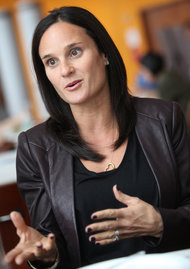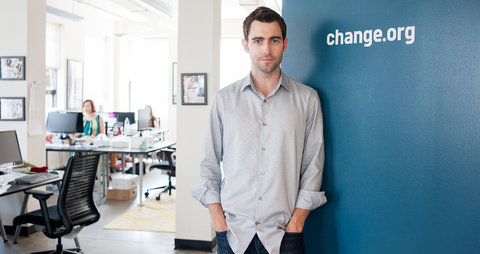
On Social Media
Generating revenue along with the buzz.
Over my last two columns, I’ve discussed how not to hire a Web developer and how to build a Website you love. But for some small businesses, there are other options — alternatives to building or refreshing a Web site.
One option is a one-page site. This is a specialty of Carbonsquare, a design shop that builds business sites of up to 10 pages using customized templates on the Webbly platform. One of Carbonsquare’s clients is a fashion-accessories retailer, Debra Wood, who has a mobile fashion boutique, DebiFashion. Ms. Wood decided a one-page site worked best for her side business. “It was so much work to constantly change my shopping-cart Web site, so for a $249 investment, I can make the changes I want and not brake the bank,” she said.
For a basic 10-page site, Carbonsquare charges $549 plus a monthly hosting and maintenance fee that runs about $30. “We decided to use the Webbly system because it’s a simple drag-and-drop system,” said Christopher Rippie, founder of Carbonsquare. “We want to help our customers understand smart design. Too many people over-design their Web sites. We did not use the WordPress platform, because it takes more time to build a Web site, which drives the cost up. We are trying to eliminate the sticker shock in Web site design and give people something they can manage themselves after we build it.”
Carbonsquare does have some drawbacks. WordPress plug-ins won’t work with the Webbly platform, search-engine optimization functionality is not built in the way it is with WordPress, and if you are blogging heavily, the system has limitations. Mr. Rippie suggests building a blog in WordPress and integrating it with the Webbly Web site.
Another option is to use Tumblr, a very easy-to-use blogging platform, as your Web site. With more than 100 million bloggers, Tumblr has an active community of users who search for content based on keyword tags. This can make it easier to build an audience quickly. It allows users to post text, photos, quotes, links, music and videos from a desktop or phone and from a browser or through e-mail. A Tumblr page works best for visual businesses, such as retail, design, food, or fashion. Some small businesses use Tumblr in addition to a WordPress blog. Tumblr allows owners to link back to e-commerce sites with coupon codes, QR codes and links to other social media accounts. Its templates are easy to use and there’s nothing to download to get started.
Diane Souter of Absolutely Fabulous Unique Gifts and Décor in Huntington Beach, Calif., uses a Tumblr page to highlight her latest products and attract a younger audience. “Tumblr is so easy to do that I could do it,” she said. “I’m able to take a photo with my iPhone and upload it to Tumblr with the hashtags and keywords, within seconds literally, and it links to my Web site.”
Ms. Souter said that while the traffic from Tumblr leads to some sales, it mainly drives buzz. “It would be great if people could click on the picture and the price comes up with the ability to make a purchase through Tumblr,” she said. That might be a way Yahoo will attempt to monetize the site, now that it has bought it for more than $1 billion.
Three months ago, Innate Family Chiropractic, based in Pasadena, Calif., started using RebelMouse to host its Web site. RebelMouse allows companies to display the latest updates on their social media accounts on the company home page; in fact, those updates can be the homepage or they can an embedded addition. Users can customize a RebelMouse site or choose from previously designed theme pages. They can also post a full-text blog post directly to RebelMouse and then add an image or a video. And they can add RSS feeds from their own blog or from other blogs they read frequently.
Paul Berry, former chief technology officer of Huffington Post, says he created RebelMouse to save small-business owners time and frustration. “We just so saw so many people struggle with their Web site almost to the point of giving up,” he said. “We knew there was a simple solution that didn’t involve developers or designers. We wanted to make people’s content shine and amplify their social media efforts.” The service costs $10 a month and integrates seamlessly with MailChimp, the e-mail service.
Innate Family Chiropractic picked RebelMouse to save time with its Web marketing and because it wanted a central place to share content on pediatric chiropractic care. The three-year-old family wellness and chiropractic center uses Twitter, Facebook, YouTube, Instagram, and Pinterest to share and generate health-related tips and articles. “I used to spend so much time educating clients and putting our content on all our social media accounts,” said Christopher Vargas, a chiropractor and owner of Innate Family. “Plugging everything into RebelMouse just made things easier.” The company pays $19.99 a month to use the service on two Web sites.
Melinda Emerson is founder and chief executive of Quintessence Multimedia, a social media strategy and content development company. You can follow her on Twitter.
Article source: http://boss.blogs.nytimes.com/2013/06/07/finding-alternatives-to-building-a-web-site/?partner=rss&emc=rss



Start: Change.org Merges Old-School Advocacy With Social Media
Start
The adventure of new ventures.
When Benjamin O’Keefe read the words of Abercrombie Fitch’s chief executive, Mike Jeffries, suggesting that the retailer wanted its clothes worn only by thin, attractive “cool kids,” he wasn’t happy. Mr. O’Keefe, 18, struggled with weight issues in middle and high school and felt compelled to speak out. He created a petition on the Web site Change.org, encouraging Mr. Jeffries to sell clothes to people of all sizes. That was on May 8; the petition has now attracted more than 75,000 signatures.
One of the people who heard about the petition was Greg Karber, a Los Angeles filmmaker. Five days after the petition went up, Mr. Karber posted a video about Mr. Jeffries’ comments on YouTube. On May 15, a vague apology appeared on Abercrombie Fitch’s Facebook page, and a week later, Mr. Jeffries met with Mr. O’Keefe. Afterward, the company issued a statement saying it would continue the dialogue and take “concrete steps” to support anti-bullying, diversity and inclusion.
This is just the kind of thing Ben Rattray says he was hoping for when he started Change.org in 2007. The idea behind it began percolating when he was a senior at Stanford in the late 1990s, studying economics and intent on a career in investment banking. While he was home for winter break, his brother, Nick, who was in high school at the time, told his family and friends he was gay. “Before he came out,” Mr. Rattray said, “Nick saw lots of homophobia and bullying, all these insulting comments made, but his friends didn’t stand up for the L.G.B.T. community, no one spoke out. And it was so painful for him, seeing people he loved not saying anything against all this hate.”
It was a pivotal moment for Ben. That conversation began his transformation, he said, from wanting to be in finance to wanting a career that revolved around social change, “enabling people to speak out for issues they care about.” He thought he would do that by studying public interest law at New York University — and then he saw Facebook. “I saw the potential power of that technology to connect people around issues of common interest,” he said.
Mr. Rattray ditched law school and wrote a 90-page business plan for Change.org and then introduced the site with a college friend, Mark Dimas. They wanted it to provide tools for social organizing and fund-raising and tried a number of approaches, including virtual political action committees, skills-based volunteerism, social fundraising and personal pledges. It turned out the simplest tool, the petition, worked best. “This merging of old-school advocacy with social media made the petition much more effective,” Mr. Rattray said.
Today, the company has 170 employees in 18 countries and is growing faster outside the United States than in it, with two million new international users each month. Last year, revenue was $15 million, which came from sponsored petitions, started and paid for by businesses and organizations. These are usually nonprofit, political and charitable organizations, although the site will accept sponsored petitions from any business or organization.
About a month ago, the site made promoted petitions available to its users worldwide. Promoted petitions allow individuals to pay to get a petition in front of Change.org’s 38 million users. The more a signer pays, the greater the number of users who will see the petition. For example, it costs $10 to promote a petition to 50 users, $100 for 500 users. The average contribution is about $19, and there is a $1,000 cap. Mr. Rattray projects that by year’s end, 10 percent of Change.org’s revenue will come from promoted petitions.
Last month, Change.org also secured a $15 million round of investment led by the philanthropic investment firm Omidyar Network. Mr. Rattray has declined to take traditional venture capital because there are few venture capitalists willing to accept his terms: he says he will never sell the company, go public or cede control. “We aren’t in the business of optimizing and maximizing profits,” he said. “We’re in the business of impact.”
The company has been certified as a B Corporation by the nonprofit B Lab, a certification available to for-profit companies that pass B Lab’s B Impact Assessment, which shows a company meets certain standards of social and environmental performance, accountability and transparency. Mr. Rattray says he would ultimately like to incorporate as a benefit corporation, which is a legal status akin to a C corporation, S corporation or L.L.C. He can’t do so because Change.org is incorporated in Delaware and that state has yet to pass legislation to allow companies to incorporate as benefit corporations. “We operate as if we were incorporated that way anyway,” Mr. Rattray said. “We respect the interests not just of shareholders but of stakeholders too.”
Those stakeholders include people like Mr. O’Keefe, the Abercrombie Fitch petitioner, and Bo Muller-Moore, a folk artist in Montpelier, Vt. Mr. Muller-Moore’s T-shirt company sells custom-designed, hand-printed T-shirts bearing the slogan “Eat More Kale.” In 2011, when Mr. Muller-Moore decided to register the slogan for a federal trademark, the fast food chain Chick-fil-A opposed him, maintaining it was too similar to its “Eat mor chikin” slogan. (Chick-fil-A declined to comment for this post).
In September, a friend of Mr. Muller-Moore’s started a petition against Chick-fil-A on Change.org. Today the petition has 41,000 signatures and has garnered press attention and support from Vermont’s governor, Peter Shumlin. Although Chick-fil-A has not stopped its efforts to block Mr. Muller-Moore’s trademark, the petition has been a boon for his business — after an Associated Press article appeared about the petition and was picked up by Yahoo, the Eat More Kale site went from 350 visitors a day to 27,500 visitors and stayed that way for three weeks.
Mr. Rattray says he wants to enable Change.org’s users to develop ongoing campaigns that have the power to shift public policy and corporate behavior over time. “The question is: How do we turn these remarkable, momentary victories into longer-term social movements?” he said. “We are focused on building tools to enable that.”
You can follow Eilene Zimmerman on Twitter.
Article source: http://boss.blogs.nytimes.com/2013/06/04/change-org-merges-old-school-advocacy-with-social-media/?partner=rss&emc=rss